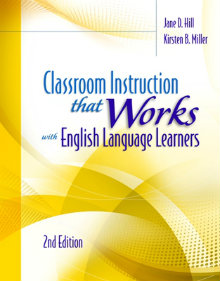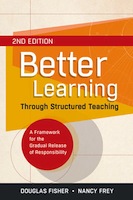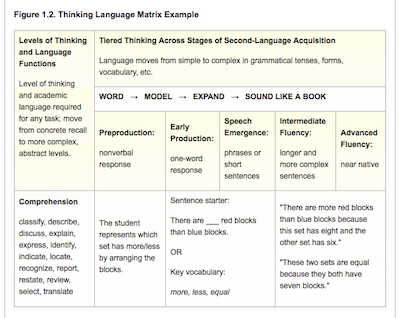Bring English Language Learners into the Conversation
Classroom Instruction that Works with English Language Learners
By Jane E. Hill and Kirsten B. Miller
(ASCD/McREL, 2013 – Learn more)

I love the Matrix. Not the movie actually (which I confess I have not seen), but the Thinking Language Matrix which is presented in the latest edition of Classroom Instruction that Works with English Language Learners.
As a newbie teacher, I devoured the second edition of Classroom Instruction that Works when I received it as an ASCD member benefit in 2012, so I was excited to review a book focused on English Language Learners, with the discussion framed by the Classroom Instruction that Works research.
Although in my opinion it’s hard to beat the original, Hill and Miller deliver three important messages that make this book worthy of its precursor.

The book is structured using the framework of Classroom Instruction that Works. In each chapter, the authors briefly review the recommendations from that book and then proceed to explain how they can be modified to support students acquiring English.
Personally, I found this structure a bit cumbersome. The marrying of the support for English language learners with the instructional strategies occasionally seems forced and makes for unnecessary repetition across the chapters. Don’t get me wrong – the instructional strategies are important, but I think the authors could have presented their ideas more directly instead of sharing them through the lens of the instructional strategies.
The Thinking Language Matrix
For me, the most crucial of those ideas is the application of the Thinking Language Matrix, a tool to design appropriate cognitive challenges for all students. The authors point out that “a lack of English language proficiency does not necessarily indicate a corresponding lack of higher order thinking skills” (p. xiv). That observation, while obvious in principle, is easy to overlook in practice. All too often teachers unwittingly assign English language learners tasks that fall on the lower levels of Bloom’s taxonomy, denying them the opportunity to practice higher-level thinking such as evaluating and synthesizing.
My biggest take-away from the book was learning how to provide appropriate higher-level thinking tasks for all students, regardless of their English ability. Hill and Miller explain how to do this and I learned from the numerous examples of the application of the matrix across grade levels and content areas.
The academic language framework
The second important theme deals with how (and why) to plan explicit language objectives for English language learners. The authors demonstrate that teachers need to attend to the language function and structures if they are to help students acquire the academic English they need to be successful at school. To achieve that objective, they have devised the “academic language framework” that breaks this complex process into manageable steps.
They provide practical and concrete examples of how to do this, such as previewing key vocabulary and concepts, using sentence starters, and teaching mini-grammar lessons. I also love the graphic organizers in the appendices that can be used to help students to summarize different types of texts (chronological, compare/contrast, description, etc).
Time for structured talk
The third important idea that runs throughout the book is providing adequate time and structure for students to talk, not only to help build language skills but also promote conceptual understanding. Hill and Miller insist that this talk be accountable with clear learning goals in mind. “Talking is not an end of itself; it must be structured to elicit rich oral academic language…” (p. 95).

Classroom Instruction that Works with English Language Learners is valuable for ensuring that English learners are challenged at higher levels with the appropriate scaffolding. The book would also be a good addition to any pre-service teacher training course or recommended reading list that needs materials on English language learning and Bloom’s taxonomy. Notwithstanding the redundancies inherent in its organization, I believe the book does meet its goal to fill a gap in instruction and learning for students who are in need of language development.
Jennifer Underwood, an elementary school teacher and former diplomat, taught fourth grade in an international school in Seoul, South Korea. She is certified in Arizona, one of the 20 states that require teachers to be trained to work with English language learners. She recently moved to Geneva, Switzerland where she is working as a high school librarian. One of her favorite projects was collaborating with other teachers and fourth grade students to integrate research skills, social studies and technology to provide information for visitors to a Seoul museum.



































